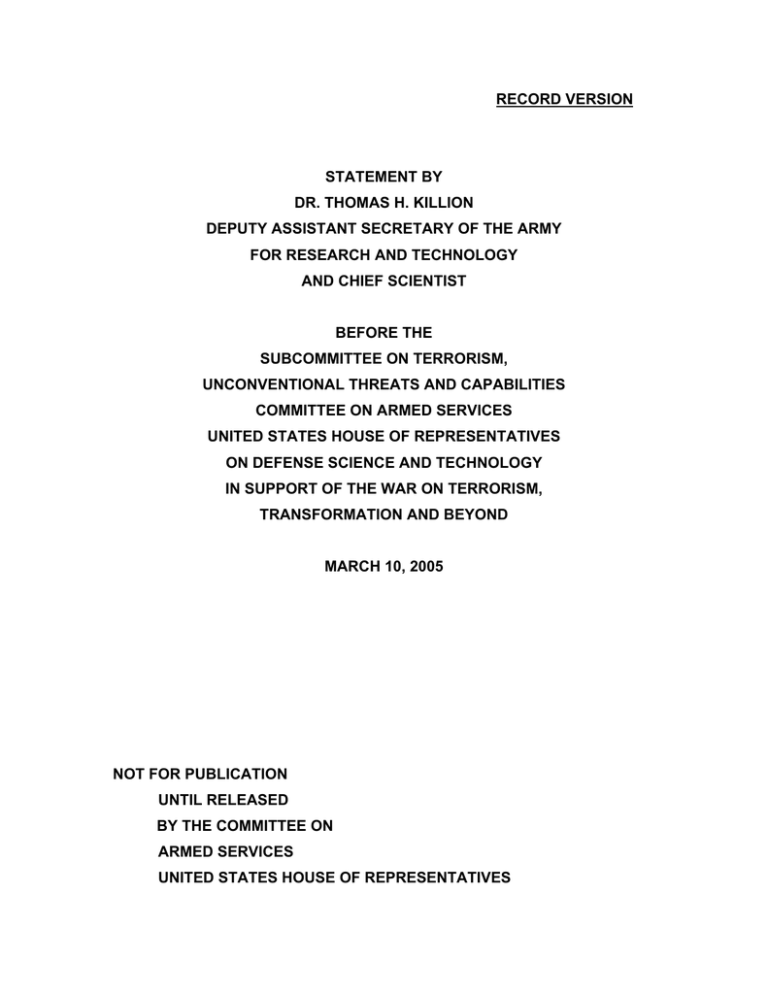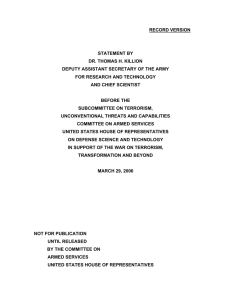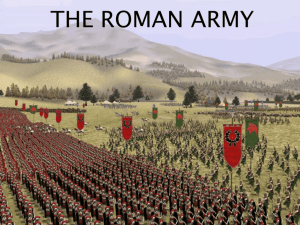RECORD VERSION STATEMENT BY DR. THOMAS H. KILLION
advertisement

RECORD VERSION STATEMENT BY DR. THOMAS H. KILLION DEPUTY ASSISTANT SECRETARY OF THE ARMY FOR RESEARCH AND TECHNOLOGY AND CHIEF SCIENTIST BEFORE THE SUBCOMMITTEE ON TERRORISM, UNCONVENTIONAL THREATS AND CAPABILITIES COMMITTEE ON ARMED SERVICES UNITED STATES HOUSE OF REPRESENTATIVES ON DEFENSE SCIENCE AND TECHNOLOGY IN SUPPORT OF THE WAR ON TERRORISM, TRANSFORMATION AND BEYOND MARCH 10, 2005 NOT FOR PUBLICATION UNTIL RELEASED BY THE COMMITTEE ON ARMED SERVICES UNITED STATES HOUSE OF REPRESENTATIVES INTRODUCTION Mr. Chairman and Members of the Subcommittee, thank you for the opportunity to describe the Fiscal Year 2006 Army Science and Technology (S&T) Program and the significant role Army S&T has in creating, adapting, and maturing technologies to enhance the Current Force and enable the Future Force. We want to thank the Members of this Committee for your support of our Soldiers who are now at war and for sustaining the investments that will provide tomorrow’s Soldiers with the dominant capabilities they will need to defend America’s interests and those of our allies throughout the world. Your continued advice and support are vital to our success. S&T CONTRIBUTIONS TO THE GLOBAL WAR ON TERRORISM Army S&T supports our Soldiers deployed to fight the Global War on Terrorism (GWOT) through three mechanisms. First, we are benefiting today from technologies that emerged from past investments. Second, we are exploiting transition opportunities from on-going S&T efforts. Third, we are leveraging the expertise of our scientists and engineers to develop solutions for unforeseen problems. The following are examples of the three approaches: 1) Reaping the return on past investments: Since the mid-1980s, the Natick Soldier Center has pursued advanced fiber technologies, in partnership with industry, to create lighter weight ballistic protection for Soldiers. This research produced the technologies to develop the outer tactical vest and components for the protective plate inserts (SAPI plates) that are used by Soldiers deployed worldwide today. 2 2) Exploiting technologies from current investments: Radio Frequency (RF) jamming technology solutions from investments in our electronic warfare technology program have been incorporated into the family of WARLOCK systems being used to defeat radio controlled Improvised Explosive Devices (IEDs). 3) Leveraging S&T expertise to solve unforeseen problems: Engineers at the Army Research Laboratory and the Tank-Automotive Research Development Engineering Center have extensive experience in designing armor and appliqués for the Army’s combat vehicles. This team rapidly responded to a critical need by designing and demonstrating armor survivability kits for High Mobility Multi-purpose Wheeled Vehicles (HMMWV) to provide protection against small arms fire and explosive blasts. These kits have now been installed on over 12,000 HMMWVs deployed for GWOT. Collectively, these efforts are enhancing Current Force capabilities for fighting the GWOT by applying relevant technologies to satisfy existing and emerging operational needs. FORCE PROTECTION Foremost in all of our minds is the need to provide the best available technologies to protect our Soldiers. The examples above—Interceptor Body Armor, electronic countermeasures (WARLOCK), and light weight armor kits for our tactical vehicles—represent a few of the “arrows” in our force protection “quiver.” Other examples include: • Acoustic and radar sensors for detecting and locating the source of rocket, artillery and mortar fire 3 • Infrared technology for counter-sniper operations, providing warning and locations for counter fire • Medical technology to protect Soldiers from endemic diseases and provide rapid treatment to save lives, such as the Chitosan Bandage and the one-handed tourniquet Beyond those technologies already contributing to the Current Force, we continue to make significant progress in maturing the sensor and kill mechanism technologies to enable active protection systems (APS). APS will significantly increase the survivability of lightweight platforms. We are funding both close-in and standoff protection systems to defeat chemical energy and kinetic energy munitions. This past year we have successfully demonstrated the ability to defeat rocket-propelled grenades fired from very close ranges. The technologies successfully defeated rocket-propelled grenade (RPG) threats in two different scenarios: defeating a single RPG fired against a moving vehicle and defeating two RPGs fired nearly simultaneously at a stationary vehicle. We are sustaining investments in these technologies as well as advanced light weight armors to provide an integrated survivability suite for FCS and other lighter weight combat systems, approaching protection levels available today only with heavy armor. We continue to pursue multiple technology solutions to identify and defeat IEDs from standoff ranges. Our work is synchronized across the Department of Defense through close coordination with the Joint IED Task Force. FUTURE COMBAT SYSTEMS (FCS) The single largest S&T investment remains the pursuit of enabling technologies for the Future Combat Systems (FCS). For 2006, we have over $426M or roughly 25% of our budget in technologies planned for spiral insertion into the FCS program. FCS is in the system development and demonstration 4 (SDD) phase of acquisition, using a spiral demonstration and fielding approach that leads to the first full Unit of Action (UA) in 2014. The FCS has been designed so that each part of the system is networked within the whole to achieve an unprecedented synergy. The S&T community is maturing technologies for both the initial spirals and the full UA capability. Key FCS technology investments include: • Networked battle command systems to enable shared situational awareness and improved decision-making • Networked lethality through standoff precision missiles and gun launched munitions • Enhanced survivability through networked lethality, improved sensors to locate and identify threats, signature management, active and passive protection systems • Semiautonomous and autonomous unmanned air and ground systems • Low-cost, multispectral sensors to find the enemy UNMANNED SYSTEMS The Army S&T program is pursuing unmanned and robotic capabilities that include: unmanned aerial vehicles (UAVs), unmanned ground vehicles and unattended sensors. These systems’ capabilities will be modular in design for spiral technology insertion and rapid adaptation to changes in mission needs. The unmanned systems and technology applications provide capabilities that are not available today, reducing risks to our Soldiers while simultaneously reducing logistics demands generated by human needs. Specific capabilities include: • Persistent surveillance and communications on the move enabled by multi-sensor and communications mission equipment packages for UAVs 5 • Unmanned air and ground systems with lethal capabilities for decisive operations against threats as they are forming As an example, the A-160 Hummingbird UAV is being developed to satisfy medium altitude long endurance requirements for communications relay and intelligence, surveillance, and reconnaissance in the Unit of Action. The A-160 is the result of a partnership with DARPA and is currently undergoing flight-testing. SOLDIER SYSTEMS TECHNOLOGY Our investments in individual Soldier technologies seek to provide soldiers with the connectivity and network lethality that is available today only through platform-based capabilities. We are also pursuing technologies to enable a lightweight, low observable, enhanced-armor protection-fighting ensemble. Other key soldier technology investments include lightweight, high-efficiency power sources; embedded physiological monitoring and limited medical treatments; multi-functional light-weight materials; embedded training; and networked sensors to enable unparalleled situational understanding. The PEO Soldier has restructured Soldier Systems development under a business plan that establishes a Lead Technology Integrator common to the S&T efforts and the SDD program. This new business approach will speed transition of technology and promote efficiency in our efforts to field Ground Soldier System capabilities that include network connectivity for compatibility with Future Force platforms. NETWORK-CENTRIC TECHNOLOGIES The S&T investments to enable network-centric operations cover the domains of communications, command and control, and sensors. These efforts mature the algorithms, protocols, high data rate processor technologies, and 6 antennas to enable mobile, wireless, tactical networks. The S&T program will develop and demonstrate real-time, continuous situational understanding by integrating data from manned and unmanned air- and ground-based sensors. Technologies include: high performance multispectral sensors (electro-optic, infrared, radio frequency, acoustic, seismic, chemical); fusion algorithms and intelligent agents to integrate data from a wide variety of networked sensors (airborne and ground). Our toughest challenge to enable network-centric operations is to overcome the technical barriers to demonstrate affordable high throughput (greater than 10Mbps) directional antennas. One approach that shows great promise to overcome these barriers uses a distributed multi-element antenna arrays to enable steerable beams. BASIC RESEARCH PROGRAM The Army Basic Research program produces new understanding to enable revolutionary advances and paradigm shifts in operational capabilities to enable the Army’s Transformation goals. This program invests in world-class expertise (government, academia and industry) and state of the art equipment to explore fundamental phenomena and exploit scientific discovery. These investments are key to the Army’s ability to win the race for speed and precision. Today’s force has overmatching capabilities enabled by technology developments such as global positioning systems, night vision devices, and precision-guided munitions. These capabilities can be traced to sustained basic research investments in decades past. The Army’s basic research program has five components: World class university-led single investigator research; focused centers to enable paradigm shifting capabilities such as nanotechnology for the soldier; research centers of excellence that advance solutions to enduring needs in the areas such as micro electronics and materials; industry-led collaborative technology alliances focused 7 on robotics, power and energy, communications and networks, advanced sensors, and decision aids; and Army unique, in-house research in behavioral science, infectious diseases and combat casualty care, environmental science, ballistics protection among others. Some examples of recent progress in Army research are: "liquid armor" to protect Soldier’s extremities; remote detection of high explosive materials by using new ultra-sensitive polymers; the creation of interactive computer based avatars for Soldier training; biotechnology for improved sensors; flexible displays for Soldier applications; ultra-small and inexpensive power supplies using dimesized microturbines; and the development of hand-sized UAVs with a full suite of sensors for communication and navigation. SCIENCE AND ENGINEERING WORKFORCE To maintain technological superiority now and into the future, we need to staff the Army Laboratories and Research, Development and Engineering Centers with top-quality engineers and scientists. We recognize this challenge— the DoD and Army must compete to obtain its future workforce from a declining national pool of highly qualified candidates. We have already taken important steps to attract and retain the best science and engineering talent available. Our laboratory personnel demonstrations have instituted multiple initiatives to enhance recruiting and reshaping of the workforce such as recruiting bonuses, pay banding flexibilities, pay-for-performance, incentive awards, and enhanced employee education and development programs. To reverse the trends in smaller numbers of students pursuing science and engineering, we have established outreach programs to attract more students to math, science, and engineering careers. We have also provided recommendations, based on our experience, for the emerging National Security Personnel System (NSPS). 8 TECHNOLOGY TRANSITION Successful transition of Army S&T products is central to enabling the Army’s Transformation. We use Technology Readiness Level metrics to assess and communicate the estimated maturity of a technology to our acquisition customers, the Program Executive Officers and Program Managers, who buy the systems that are provided to our soldiers. The S&T community’s outcomeoriented approach to technology development has yielded significant progress over the past few years. Examples of successful S&T efforts that have transitioned to programs of record include: • FCS to System Development and Demonstration (SDD) • Line-of-Sight Anti Tank to SDD • Objective Crew Served Weapon to SDD • Tactical C2 protection algorithms to PM Warfighter Information Network-Tactical (WIN-T) • Network Fires (Cooperative program with DARPA) to SDD as Non-Line-of-Sight Launch System CONCLUSION The Army must have a diverse S&T portfolio to be responsive to current and future warfighter needs. The S&T community seeks technological solutions that can be demonstrated in the near-term, explores the feasibility of new concepts for the mid-term, and explores the imaginable for an uncertain far-term future. The Army S&T community has committed our intellectual resources—our people—and our facilities and funding to maintain the momentum of the Army’s Transformation! 9





